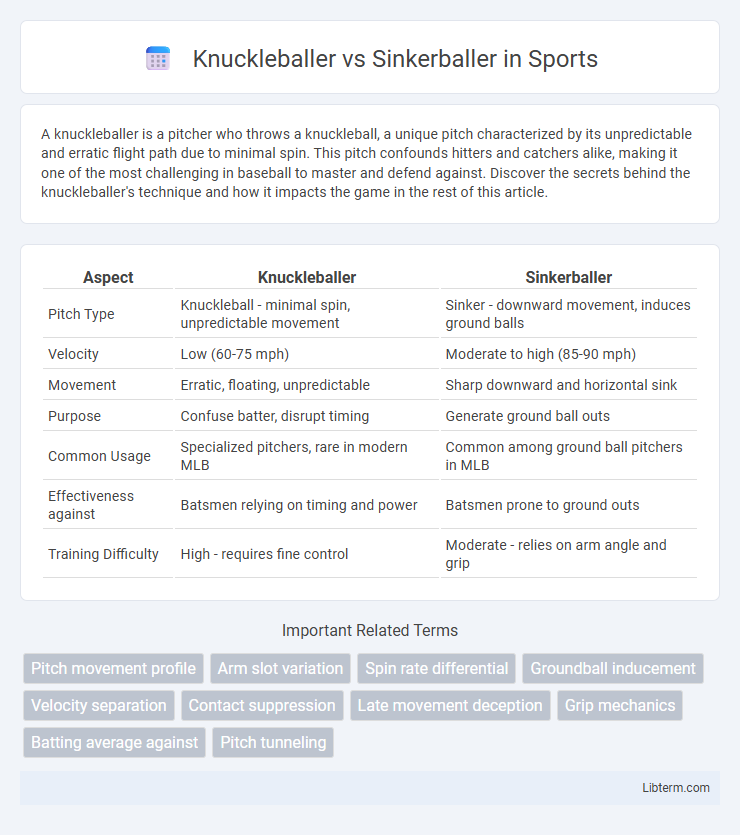A knuckleballer is a pitcher who throws a knuckleball, a unique pitch characterized by its unpredictable and erratic flight path due to minimal spin. This pitch confounds hitters and catchers alike, making it one of the most challenging in baseball to master and defend against. Discover the secrets behind the knuckleballer's technique and how it impacts the game in the rest of this article.
Table of Comparison
| Aspect | Knuckleballer | Sinkerballer |
|---|---|---|
| Pitch Type | Knuckleball - minimal spin, unpredictable movement | Sinker - downward movement, induces ground balls |
| Velocity | Low (60-75 mph) | Moderate to high (85-90 mph) |
| Movement | Erratic, floating, unpredictable | Sharp downward and horizontal sink |
| Purpose | Confuse batter, disrupt timing | Generate ground ball outs |
| Common Usage | Specialized pitchers, rare in modern MLB | Common among ground ball pitchers in MLB |
| Effectiveness against | Batsmen relying on timing and power | Batsmen prone to ground outs |
| Training Difficulty | High - requires fine control | Moderate - relies on arm angle and grip |
Introduction to Knuckleballers and Sinkerballers
Knuckleballers excel by throwing an unpredictable knuckleball, which minimizes spin and causes the pitch to flutter erratically, baffling hitters and catchers. Sinkerballers rely on sinkers that generate downward movement due to increased spin and grip pressure, inducing ground balls and weak contact. Both pitching styles emphasize movement but differ in approach: knuckleballers use deception through minimal spin, while sinkerballers leverage velocity and downward force to control the batter's swing.
Pitch Mechanics: Knuckleball vs Sinker
Knuckleballers generate unpredictable ball movement by releasing the ball with minimal spin, causing it to flutter due to air resistance, which relies heavily on a loose grip and relaxed wrist motion. Sinkerballers utilize a fastball grip but apply downward finger pressure and pronation of the wrist at release, inducing topspin that creates a sharp downward break. These distinct pitch mechanics affect hitters' timing and swing plane, with the knuckleball's erratic trajectory contrasting against the sinker's controlled darting motion.
Historical Significance of Both Pitching Styles
Knuckleballers, exemplified by legendary pitchers like Phil Niekro and Tim Wakefield, have historically challenged hitters with an unpredictable, fluttering pitch that defies conventional spin mechanics. Sinkerballers, such as Greg Maddux and Roy Halladay, revolutionized pitching by inducing ground balls and weak contact through a fastball variant with heavy downward movement. Both styles have significantly influenced baseball strategy, shaping how pitchers approach control, deception, and batter engagement throughout Major League Baseball history.
Notable Knuckleballers in Baseball History
Notable knuckleballers in baseball history include Hoyt Wilhelm, Tim Wakefield, and R.A. Dickey, each renowned for their mastery of the unpredictable pitch causing minimal spin and erratic movement. Unlike sinkerballers who rely on a sinking fastball to induce ground balls, knuckleballers use a slow, fluttering pitch to confuse hitters. This unique pitching style has made knuckleballers rare but highly effective, often extending careers beyond typical fastball pitchers.
Legendary Sinkerballers: Masters of the Drop
Legendary sinkerballers like Mariano Rivera and Derek Lowe mastered the art of generating heavy downward movement, causing hitters to ground out with ease. Their ability to control velocity and seam orientation transformed the sinker into an effective weapon against power hitters. These pitchers exemplify how a well-executed sinker can dominate lineups by inducing weak contact and double plays.
Advantages and Challenges: Knuckleballers
Knuckleballers excel in disrupting hitters' timing due to the unpredictable, fluttering movement of their pitch, making it difficult for batters to make solid contact. The primary challenge lies in controlling the pitch, as the lack of spin often leads to inconsistent location and increased walk rates. Despite these difficulties, knuckleballers can extend their careers by reducing arm strain and keeping hitters off-balance with their unique delivery.
Strengths and Weaknesses: Sinkerballers
Sinkerballers excel at inducing ground balls due to their heavy movement and late downward break, which effectively generates weak contact and double-play opportunities. Their main weakness lies in limited strikeout potential, making them reliant on defense and susceptible to damage if their sinker lacks consistency or if hitters adjust to the pitch's movement. Control issues can also arise, leading to more walks and higher pitch counts compared to power pitchers.
Batter Reactions: Hitting Against Knuckleballs vs Sinkers
Batters facing knuckleballers often struggle with unpredictable pitch movement, leading to decreased contact rates and increased swings-and-misses. Sinkers generate more consistent downward movement, prompting batters to adjust by hitting ground balls and focusing on early bat speed to counteract the pitch's sharp drop. The erratic flutter of knuckleballs disrupts batter timing more than the sinker's reliable sinking action, requiring distinct hitting approaches and timing strategies.
Strategy and Usage in Modern Games
Knuckleballers rely on unpredictable, fluttering pitches to disrupt hitters' timing, often used in late-inning situations to neutralize power hitters by inducing weak contact or swings and misses. Sinkerballers focus on generating ground balls through a heavy, sinking pitch, ideal for double-play scenarios and pitchers with strong infield defense support, commonly employed in early innings to maintain pitch efficiency and control the running game. Modern strategies integrate knuckleballers sparingly due to their rarity and necessity for specialized catchers, while sinkerballers remain staple starters or relievers due to their consistent effectiveness in generating groundouts and managing pitch counts.
The Future of Knuckleballers and Sinkerballers
Knuckleballers continue to offer strategic value in baseball with their unpredictable pitch movement, attracting niche pitchers who capitalize on deception rather than velocity. Sinkerballers maintain relevance by inducing ground balls and controlling the strike zone, appealing to teams emphasizing defensive strength and pitch efficiency. Advancements in training and analytics suggest a sustained, though specialized, future for both pitch types within evolving pitching arsenals.
Knuckleballer Infographic

 libterm.com
libterm.com